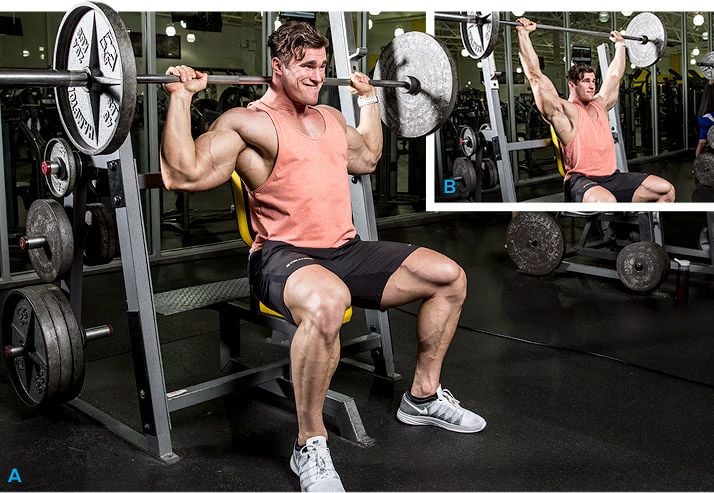Table of Contents
You may have already come across the following statements: “When I was younger, I was so stupid. I don’t even know how I gained muscle.” Frankly, even a miserable and borderly dangerous training program will produce results if you train hard, don’t skip trainings and you dedicate your life to it. There is also some truth in the expression “young and stupid.” Young exercisers often do things that don’t hurt them very much at the time, but their “sins of youth” often show up and hit them in the 30’s and 40’s. See what mistakes we make most often and try to avoid them.
Mistake #1: insufficient warming-up
“I thought overheating would weaken me on my epic bench press. Yes, a bench press with a maximum of one repetition, which I tried every week by the way. For many years, I was warming up before chest training with chest training on a flat bench! I was lifting the barbell weighing 61 kg for 15 repetitions.”

Let’s say your squat training is set to 4 sets of 5 reps with a weight of 152 kg. Here’s how the quality warm up looks like:
| 1 | empty bar | 5 |
| 2 | 61 kg | 5 |
| 3 | 84 kg | 5 |
| 4 | 102 kg | 5 |
| 5 | 125 kg | 3 |
| 6 | 134 kg | 2 |
| 7 | 143 kg | 1 |
| 8 | 152 kg | 4 – first training series |
Between sets rest only when adding weight.
You might be interested in these products:
Mistake 2: Workout too hard
Putting more and more weight on the bar is one of the most effective ways to build muscle and strength, but it is also a game of fire – at least in the long run. Few exercisers who regularly lift heavy weights in their 20s are not suffering any chronic injuries in their 40s. As Bryan puts it, it is no exception: “For me it is the shoulders, lower back and neck – my unholy trinity. Basically, I did not get too bad. Many exercisers hung a belt in their forties because of joint problems.“

However, this does not mean that such training must be excluded forever. Your body will not make progress and recover directly in proportion to your gym years. If you push your trainings beyond your limits too much, without intelligent workouts and planning, this can be a disaster.
Yes, you should train hard, but you should not always do it if you want to train throughout your life. Plan periods of low intensity and more volume that will follow high-intensity training cycles.
Mistake 3: Too much of unnecessary load
According to coach Brad Schoenfeld, author of “The M.A.X. Muscle Plan”, the optimal number of muscle growth series varies from individual to individual, and depends on genetics, training experience, and nutritional status. Some exercisers respond better to a large number of series and a moderate number of reps, known as high-load training. This is generally a “safer” way in terms of heavy weight training that helps build muscle.
Excessive load, even too many repetitions and series, can cause considerable abrasion of joints and tendons, especially if you do not follow an excellent technique of performing exercises or if you repeat the same movement too often, despite different tools and accessories. Needless to mention the declining gains from the training stimulus.

Schoenfeld says that optimum results are achieved by a periodic approach in which the number of series is adjusted according to the training cycle. For example, during the first month you will perform 8-10 sets for the muscle group per week. Then the second month 12-15 sets, and finally during the third month 18-20 sets per week.
While overtraining (a term you’ve already come across when you’re doing high-weight workouts) is a bit of a specter because only few exercisers will achieve it, but by overreaching it he can approach it. This can weaken the immune system and negatively affect hormone levels, which is detrimental.
Mistake 4: Insufficient diversity
Everyone understands that in weight training, adding weight or increasing the number of repetitions is a way to increase muscle volume. This is the principle of progressive congestion. However, there is another method that does not receive as much attention as it deserves: variety of exercises.

Put simply: diversity in strength training vs. in hypertrophic training (muscle growth) can produce different results. In strength training, diversity can be counterproductive as your body focuses all of your attention on several key strokes. Conversely, individual hypertrophic training exercises stimulate muscles to grow because the body adapts relatively quickly to exercise. It’s good to surprise your body by adding a little change to your routine movements. If you run out of exercise ideas, the internet offers a heap of articles with exercise databases. Get inspired!
Mistake 5: Too much of a consistency
As we noted above, hard work done consistently brings great results. However, there is a point where you can be too consistent, not only when selecting exercises, but also at their frequency.

Surely you also had a period of life during which you trained every part of your body once a week. We assume that you thought that if you adhere to it for a long time, it will work. Over time, however, you have probably learned that you must always be one step ahead of your body’s ability to adapt. In addition to hard work and proper intensity, change is also essential. You should therefore change your exercise frequency at least once every three months.
Mistake 6: Too many dangerous exercises
There are no explicitly dangerous or bad exercises. There are only exercises with a higher risk of injury, as well as exercises that are inappropriate for your goals, flexibility or musculoskeletal health.

For example, press with a great dumbbell behind the head is a great lift, but for someone with not the best mobility, it is a very bad choice. It is much better to use one-handed dumbbells or fitness machines. Basically, what is good for one may not be good for everyone. If it hurts, don’t do it.
Here are some common “offenders” and their more friendly counterparts:
| Press with a large dumbbell behind head | Shoulder presses with dumbbell with neutral grip, Dumbbell shoulder presses (with one hand) |
| Triceps push-ups | Pullups on parallel bars (Partial-range dip), Eccentric push-ups (Eccentric – only dip) |
| Press with a large dumbbell behind the head on a bench | Sitting pullups, Pullups |
| Laying down triceps extensions | Triceps extensions with dumbbells, Triceps presses barbell or EZ bar |
| Press on a bench with large dumbbell with narrow grip | Barbell rows with wide grip, low rows |
Mistake 7: Inadequate exercise planning
Let me guess: you probably started your exercise path with biceps, triceps and chest bombing. Eventually, the shoulders, back and legs began to attend the party. That’s great, but what about the smaller muscle groups you’ve ignored?

Why wait until thirty to start training? Start focusing on the muscles you might not see right now in the mirror. This way you will cross the threshold of thirty, looking symmetrical and not having to catch up.
Mistake 8: Insufficient work on flexibility
Flexibility, mobility, dynamic stretching, static stretching – everything you can think of. This is still being avoided by many people so that they can do more repetitions in the opposite direction high rows (or any other exercise). Again stupidity. Over time, however, they will be forced to regain dexterity from their youth, or at least to loosen their hips a little.
The great thing about flexibility is that once you have it, you can keep it relatively simple. Another advantage is that the bodybuilding style of training, which often requires a full range of exercise, can help to some extent.

Some day-to-day activities such as sitting all day behind your computer will slowly but surely pull you into a pretzel. Usually even the harshest gym training is not enough against these forces. Start stretching before and after training, before you stretch in the presence of moans.
You do not need dozens of exercises to improve this situation. In fact, you only need a small series of effective exercises that you do precisely. Here are some pre-workout exercises for the lower body and one on the shoulders from mobility expert Dean Somerset:
Mistake 9: Poor health promotion
Do you also know someone whose idea of regenerating or recovering from training means having a sweet bomb and playing games until 2 next morning? Over time, however, everyone gets to a level where 2/3 of his lifestyle begins to revolve around better sleep, a balanced nutrition and the best possible regeneration. The result is a better understanding of your body, shifting energy to make you feel and even healthier, better relaxed, and of course, muscle mass growth will be a reward.

You will certainly not see the results of taking omega 3 or fish oil, vitamin B, C, vitamin D, magnesium and eating a ton of vegetables from day to day, but your future self will thank you.
Mistake 10: Incorrect power distribution
As coach Bryan Krahn recalls, he used to get stressed by consuming exact grams of protein or whether more biceps strokes should be involved. However, he realized that these things were still important, but he should look at the training differently.
He used to lift the weights as high as he could and did everything to look good. Lifting heavy weights for him is no longer a way how he gets strength, will look good or will be healthy, but it is rather an everyday investment in himself. Excellent fitness, pumped muscles and personal records are fine, but they are just a cherry on the cake. Train because you love it and it makes you better.

If you train consistently, eat wisely and get enough rest, your figure will also improve. However, this whole thing will be a simpler process if good habits are already part of your daily routine. That means you have to start while you’re young – right now. You cannot undo the time hand. Start taking care of your body today and reap the harvest tomorrow.
If you think this article may help your friends or you just liked it, please support it by sharing.


Add a comment